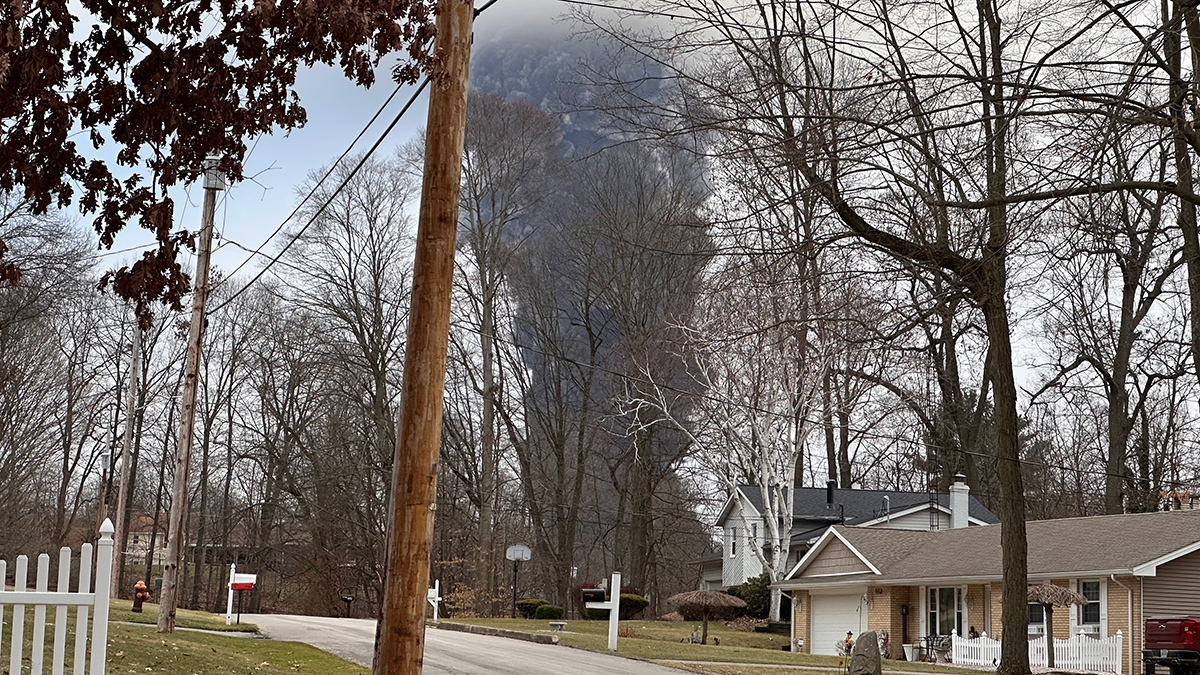On 3 February 2023, a train carrying industrial chemicals derailed in the small town of East Palestine, Ohio. Some of the cars carried flammable material, so officials intentionally released and burned the cargo to prevent explosions. Authorities issued a mandatory evacuation order, citing the explosion risk and potential exposure to toxins.
The order was lifted on 8 February. After residents returned, some reported health symptoms consistent with exposure to airborne toxic chemicals. Scientists have now confirmed that some chemicals lingered in parts of East Palestine for weeks after the controlled burn.
For 2 days in late February, researchers drove around the town in a van outfitted with sensitive detectors. Data from the van and EPA stationary air samplers suggest that though concentrations of many pollutants decreased substantially in the weeks after the derailment, levels of the respiratory irritant acrolein still hovered above risk thresholds for long-term exposure.
“Our data agrees with EPA [data],” said atmospheric scientist Albert Presto of Carnegie Mellon University in Pittsburgh. “But we’re able to show, with the mobile sampling, sort of a more detailed picture of what the exposure patterns look like.”
Monitors on the Move
As part of the emergency response, the EPA installed a network of stationary devices across East Palestine to collect outdoor air samples. Technicians later analyzed these samples in a lab to determine whether levels of specific target contaminants were above health and safety thresholds.
“That’s the traditional way of doing things,” Presto said. But it’s not the only way to monitor airborne contaminants.
Presto and his colleagues took air quality monitoring on the road by outfitting a van with a proton transfer mass spectrometer, which can measure the concentrations of thousands of different compounds every second, allowing researchers to track how chemical concentrations vary through time and among different areas.
The van had already been prepared for a sampling campaign in Pittsburgh, which is just over an hour’s drive from East Palestine—though the researchers didn’t start driving immediately after the derailment.
“When it happened, the thought definitely crossed my mind,” Presto said. “But it was also literally a towering inferno.” The researchers headed to East Palestine a few weeks later because residents were still reporting odors and health concerns. On 20 and 21 February, they drove around the small town between midday and about 8 p.m., taking measurements with the van’s mass spectrometer.

In agreement with the publicly available data from the EPA’s stationary monitors, the mobile monitor detected levels of benzene, toluene, xylenes, and vinyl chloride below their respective safety thresholds for medium-term (15 days to 1 year) and long-term (1+ years) exposure. However, the researchers reported levels of acrolein, which irritates the respiratory tract and can cause lung damage with chronic exposure, up to 6 times higher than rural background levels near the derailment site during the day. (Nighttime concentrations sunk to below rural background levels.)
Traditional targeted analyses, such as those performed by the EPA, detect a predefined set of specific, known chemicals. But the van’s mass spectrometer could also pick up whiffs of unidentified compounds. Some of these chemicals seemed to track with acrolein levels or were concentrated in hot spots around the derailment site—patterns that suggests that they could be contaminants, too.
“There were definitely [chemicals] in the nontargeted analysis that were correlated with acrolein that we wouldn’t have seen,” Presto said. Further analysis would be needed to determine what, exactly, these chemicals were and whether they’re hazardous.
Monitoring After a Disaster
“This is very useful and provides a new perspective not possible with the stationary monitor.”
“This is very useful and provides a new perspective not possible with the stationary monitor,” said public health researcher Lianne Sheppard of the University of Washington in Seattle, who wasn’t involved in the study. Compared to stationary monitoring, she said, the mobile air monitor has some important strengths, such as allowing researchers to use just one set of expensive instruments over a wide area and revealing how contamination varies from place to place.
“However,” Sheppard added, “for a situation like a disaster, where the situation is evolving rapidly, I think more research is needed to understand how to apply this tool.”
Presto said that one obstacle to using mobile, nontargeted monitoring strategies during disasters is actually their data richness. “Doing this mobile sampling with these high-resolution instruments is a little bit of a double-edged sword,” he said. “We can learn a lot; we generate a lot of data. The downside is it is really a lot of data. We’re measuring every second, [and] every second we have 1000s of [chemicals] that we could potentially interrogate.”
“It’s critical to get [results] fast, but also be right.”
So developing fast, accurate methods for both analyzing the enormous data sets that come from mobile, nontargeted analyses and communicating the results is an important next step, Presto said.
“I literally had people contacting us when we first released some of this data back in March…saying, you know, can my parents go back to their house? People have these very real concerns about their everyday lives,” Presto said. “It’s critical to get [results] fast, but also be right.”
—Elise Cutts (@elisecutts), Science Writer

